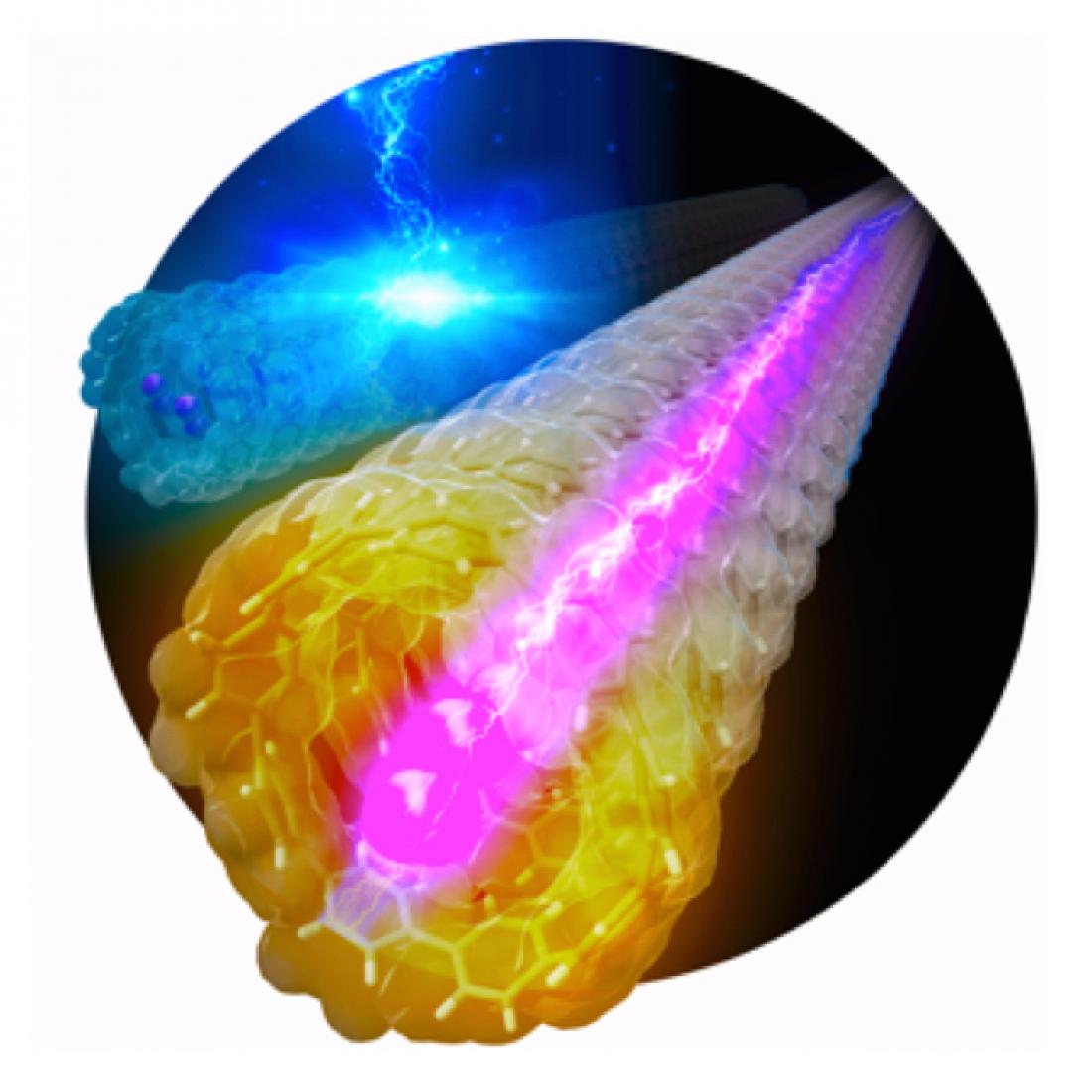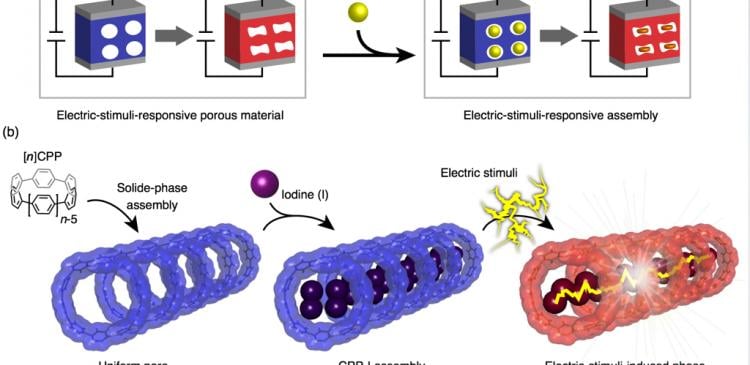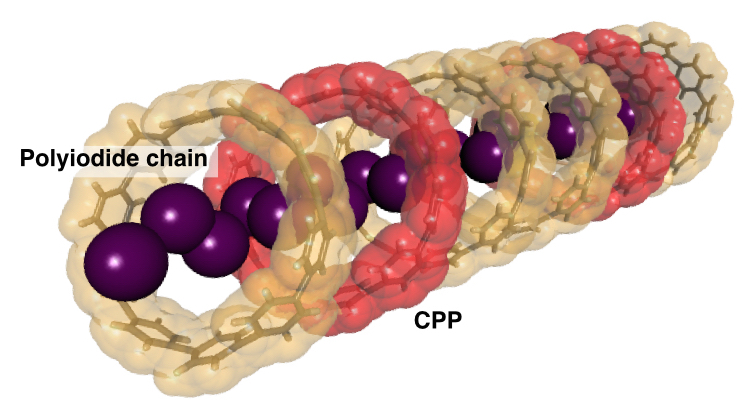An electric stimulus induces the hydrocarbon nanoring cycloparaphenylene (CPP)-iodine assembly to show electronic conductivity and white light emission.
~ New synthetic approach could spark development of other dynamic materials ~
Scientists at Nagoya University have developed a new way to make stimuli-responsive materials in a predictable manner. They used this method to design a new material, a mixture of carbon nanorings and iodine, which conducts electricity and emits white light when exposed to electricity. The team’s new approach could help generate a range of reliable stimuli-responsive materials, which can be used in memory devices, artificial muscles and drug delivery systems, among other applications.
Nagoya, Japan – Stimuli-responsive materials alter their own properties in response to external stimuli, such as photo-irradiation, heat, pressure and electricity. This feature can be controlled for a wide range of uses, such as in optical discs, computer memories and displays, as well as artificial muscles and drug delivery systems.
Researchers have been working to develop new stimuli-responsive materials in a predictable fashion. However, it has been extremely difficult to design and control the complex molecular arrangements of the materials.
Now, a simple and reliable method to synthesize stimuli-responsive materials has been developed by a team led by Nagoya University’s JST-ERATO Itami Molecular Nanocarbon Project and the Institute of Transformative Bio-Molecules (ITbM). The results of this study were recently reported in the journal Angewandte Chemie International Edition.
The ‘responsive porous host’ method takes a molecule with a porous framework and binds to it a ‘guest’ molecule that is likely to react to external stimuli. In this case, the team found that [10]cycloparaphenylene ([10]CPP), a hydrocarbon molecule composed of 10 para-connected benzene rings, made an ideal host when combined with iodine (I). Iodine situated itself inside the porous carbon rings, and reacted to electric stimulation. Not only did it conduct electricity, it also emitted a white light, which is unusual. Typically, many other components are required to obtain the white color. This shows the potential of the new material, [10]CPP-I, for next generation illumination systems.
“This ‘responsive porous host’ approach is expected to be applicable to different stimuli, such as photo-irradiation, heat application and pH change, and open the path for devising a generic strategy for the development of stimuli-responsive materials in a controllable and predictable fashion,” said Dr. Hirotoshi Sakamoto, a group leader of the JST-ERATO project.
Synthesizing the material is surprisingly simple — the researchers mixed carbon nanorings (CPP) and iodine together, and let it dry. X-ray crystallography confirmed that the iodine molecules line up inside the hollow core of the aligned nanorings.
The team tried several variations of the mixture, changing the number of carbon nanorings, and found that 10 rings led to the most dynamic iodine atom movement and the most sensitive response to external environmental changes.
When a direct current was applied to [10]CPP-I, the bulk resistivity of the sample became approximately 380 times lower, indicating that it conducted electricity rather than resisting electrical transmission. The bulk resistivity in mixtures with 9 or 12 nanorings did not decrease nearly as much. These results show that pore size in the nanoring assembly controls the response to electrical stimulation.
“One of the most difficult parts of this research was to investigate how the electric conductivity of [10]CPP-I is turned on by electric stimuli,” said Dr. Noriaki Ozaki, a postdoctoral researcher of the JST-ERATO project. “Although it only took us about three months to synthesize the molecule and discover its electric-stimuli-responsive properties, it took another year to discover the origin of its properties.”
The team finally figured out how the electric conductivity of [10]CPP-I is turned on by electric stimuli, using X-ray absorption near-edge spectroscopy (XANES), Raman spectroscopy, and fluorescence spectroscopy. These analyses showed that the iodine atoms in the carbon nanorings form extended polyiodide chains when stimulated by electricity, which gave the material electrical conductivity.
The researchers also discovered that electric stimuli can switch the photoluminescence color of [10]CPP-I from a green-blue color to a white color. White luminescence means that the fluorescence spectrum of [10]CPP-I covers the whole visible light range. Spectral broadening is attributed to the irregular distribution of the electronic structures of CPPs, which is caused by the formation of polyiodide chains. The white luminescence of [10]CPP-I is a rare example of white illumination material from a single molecular assembly; white light emission is usually achieved by mixing several components of different colors.
“We were really excited to develop this simple yet powerful method to achieve the synthesis of external-stimuli-response materials,” said Professor Kenichiro Itami, director of the JST-ERATO project and center director of ITbM.
This article “Electrically-Activated Conductivity and White Light Emission of a Hydrocarbon Nanoring-Iodine Assembly” by Noriaki Ozaki, Hirotoshi Sakamoto, Taishi Nishihara, Toshihiko Fujimori, Yuh Hijikata, Ryuto Kimura, Stephan Irle and Kenichiro Itami is published online in Angew. Chem. Int. Ed. DOI: 10.1002/anie.201703648 (http://dx.doi.org/10.1002/anie.201703648)
JST-ERATO Itami Molecular Nanocarbon Project (http://www.jst.go.jp/erato/itami/index.html)
The JST-ERATO Itami Molecular Nanocarbon Project was launched at Nagoya University in April 2014. This is a 5-year project that seeks to open the new field of nanocarbon science. This project entails the design and synthesis of as-yet largely unexplored nanocarbons as structurally well-defined molecules, and the development of novel, highly functional materials based on these nanocarbons. Researchers combine chemical and physical methods to achieve the controlled synthesis of well-defined uniquely structured nanocarbon materials, and conduct interdisciplinary research encompassing the control of molecular arrangement and orientation, structural and functional analysis, and applications in devices and biology. The goal of this project is to design, synthesize, utilize, and understand nanocarbons as molecules.
About WPI-ITbM (http://www.itbm.nagoya-u.ac.jp/)
The Institute of Transformative Bio-Molecules (ITbM) at Nagoya University in Japan is committed to advance the integration of synthetic chemistry, plant/animal biology and theoretical science, all of which are traditionally strong fields in the university. ITbM is one of the research centers of the Japanese MEXT (Ministry of Education, Culture, Sports, Science and Technology) program, the World Premier International Research Center Initiative (WPI). The aim of ITbM is to develop transformative bio-molecules, innovative functional molecules capable of bringing about fundamental change to biological science and technology. Research at ITbM is carried out in a "Mix Lab" style, where international young researchers from various fields work together side-by-side in the same lab, enabling interdisciplinary interaction. Through these endeavors, ITbM will create "transformative bio-molecules" that will dramatically change the way of research in chemistry, biology and other related fields to solve urgent problems, such as environmental issues, food production and medical technology that have a significant impact on the society.
About JST-ERATO (http://www.jst.go.jp/erato/en/about/index.html)
ERATO (The Exploratory Research for Advanced Technology), one of the Strategic Basic Research Programs, aims to form a headstream of science and technology, and ultimately contribute to science, technology, and innovation that will change society and the economy in the future. In ERATO, a Research Director, a principal investigator of ERATO research project, establishes a new research base in Japan and recruits young researchers to implement his or her challenging research project within a limited time frame.
Author Contact
Professor Kenichiro Itami
Institute of Transformative Bio-Molecules (WPI-ITbM), Nagoya University
Furo-cho, Chikusa-ku, Nagoya 464-8601, Japan
TEL/FAX: +81-52-788-6098
E-mail: [email protected]
Dr. Hirotoshi Sakamoto
ERATO Itami Molecular Nanocarbon Project
Graduate School of Science, Nagoya University
Furo-cho, Chikusa-ku, Nagoya 464-8601, Japan
E-mail: [email protected]
Dr. Noriaki Ozaki
ERATO Itami Molecular Nanocarbon Project
Graduate School of Science, Nagoya University
Furo-cho, Chikusa-ku, Nagoya 464-8601 Japan
E-mail: [email protected]
Media Contact
Dr. Aki Miura
JST-ERATO Itami Molecular Nanocarbon Project
Nagoya University
Furo-cho, Chikusa-ku, Nagoya 464-8601, Japan
TEL/FAX: +81-52-789-5916
E-mail: [email protected]
Dr. Ayako Miyazaki
Institute of Transformative Bio-Molecules (WPI-ITbM), Nagoya University
Furo-cho, Chikusa-ku, Nagoya 464-8601, Japan
TEL: +81-52-789-4999 FAX: +81-52-789-3053
E-mail: [email protected]





